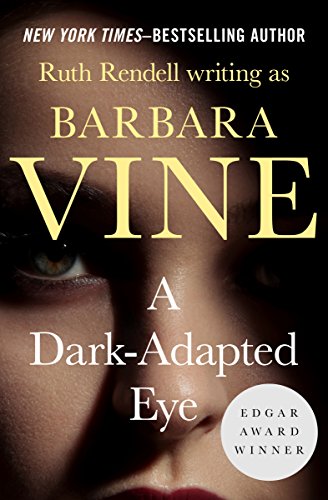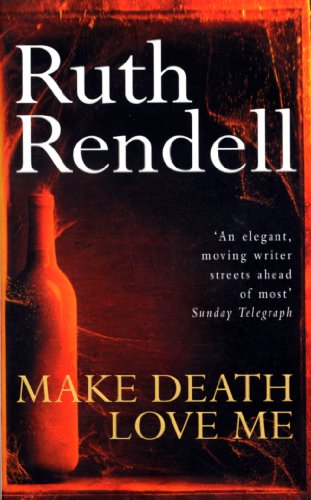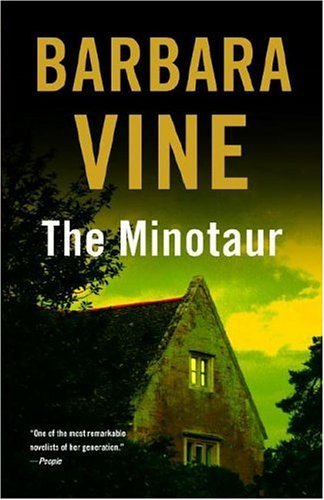
Description
From Publishers Weekly Starred Review. British veteran Rendell ( The Rottweiler ) delivers the best novel she's written in years, featuring elderly Gwendolen Chawcer and her younger tenant-in-the-attic, "Mix" Cellini. The unlikely housemates share St. Blaise House, Chawcer's rotting London mansion, full of many generations of dead insects and past dreams of upper-middle-class glory. Both Chawcer and Cellini are looking for love in all the wrong places. Boozy, delusional Cellini—who earns his keep fixing fitness equipment and is a "fan" of real-life murderer Harold Christie—obsesses about supermodel Nerissa Nash. He'll do anything to snag her attention and assume his "rightful" place as her husband. The Miss Havisham–like Chawcer pines for Dr. Stephen Reeves, whom she last saw when he attended her dying mother in 1953. Cellini spins out of control first, killing a clingy, "unworthy" date, then hiding her beneath the floorboards in his apartment. Rendell exhibits all her trademark virtues: vivid characters, a plot addictive as crack and a sense of place unequaled in crime fiction. Copyright © Reed Business Information, a division of Reed Elsevier Inc. All rights reserved. From The New Yorker The British crime novelist Ruth Rendell is the author of fifty-odd books in which things go horribly, intricately wrong. (Her creepiest, most disturbing novels are written under the pseudonym Barbara Vine.) In her latest, a fitness-machine repairman's dual fixations-on a famous Notting Hill serial killer, hanged half a century before, and on a young black model in thrall to a soothsayer-collide. The novel lacks the modifying, likable intelligence that Rendell's recurrent character, Chief Inspector Wexford, brings to other of her works, and the result is a wan puzzler painted in broad strokes. However, her portrait of the repairman's landlady-a Miss Havisham among her scruffy bits and bobs, who reads Darwin and seems to take a dim view of the evolution of man post-1900-has the zany, wry touch of a master. Copyright © 2005 The New Yorker From Bookmarks Magazine Rendell has won almost every coveted mystery prize, and in Britain she is bested only by P. D. James, to whom she dedicates this book. But her following in America is smaller, and her publisher is betting on 13 Steps Down to change that (of course, itx92s bet on this in the past as well). The novelx92s fascinating characters, swift pace, unflappable tone, and inside look into a murdererx92s remorseless mind will intrigue most readers. Chawcer evoked comparisons to Dickensx92s Miss Havisham and even Dostoevskyx92s old woman in Crime and Punishment . A whimpering ending may bother some. Copyright © 2004 Phillips & Nelson Media, Inc. From Booklist Rendell, like P. D. James (to whom she dedicates this book), has mastered the peculiarly British form of chiller, in which a matter-of-fact narrator guides the reader though the Stygian depths of a murderer's psyche. It is the calm tone, the same voice used for a victim planning a night out and a murderer planning to end the victim's night out, that is unnerving. Rendell, winner of three Edgars and a UK Grand Master Award, is especially good at creating evocative settings. In her latest, a stand-alone suspense story, two London houses hold symbolic center-stage. One house has just been torn down. The novel's murderous young man sees this as an irreparable loss because it was in this house that a serial killer (whom he greatly admires) lured young women under the guise of performing illegal abortions. The second house, in which the young man rooms (and commits his first murder), is owned by a Miss Havisham-like recluse with her own connection to the historic murderer's home. In a lesser writer's plotting, the young man's obsession with a model and the old woman's obsession with reclaiming her lost love would be ploddingly predictable. Rendell, however, infuses her main character's schemes with so much atmosphere and even compassion that readers will find the tale achingly suspenseful and realistic. Connie Fletcher Copyright © American Library Association. All rights reserved PRAISE FOR RUTH RENDELL“Surely one of the greatest novelists presently at work in our language.” —Scott Turow“Those who haven’t read her books have missed something unique and wonderful.” —Tony Hillerman“One of the most remarkable novelists of her generation.” — People “She has transcended her genre by her remarkable imaginative power to explore and illuminate the dark corners of the human psyche.” —P. D. James“The best mystery writer in the English-speaking world.” — Time “Ruth Rendell is my dream writer. Her prose style, so intricate in design and supple in execution, has the disquieting intimacy of an alien touch in the dark.” —Marilyn Stasio, The New York Times Book Review “Unequivocally the most brilliant mystery writer of our time. She magnificently triumphs in a style that is uniquely hers and mesmerizing.” —Patricia Cornwell“One of the finest practitioners of her craft in the English-speaking world.” —Joyce Carol Oates“Her clear, shapely prose casts the mesmerizing spell of the confessional.” — The New Yorker Ruth Rendell is celebrated around the world as a novelist at the peak of her craft. The British Crime Writer’s Association has honored her with four Gold Daggers, a Silver Dagger, and the Diamond Dagger for outstanding contribution to the genre. In the United States she has been acknowledged by a remarkable total of three Edgar Awards from the Mystery Writers of America, as well as the organization’s Grand Master Award for lifetime achievement. Over the past forty years Ruth Rendell has created an extraordinary body of literary work. In addition to seven volumes of short stories, one novella, and two works of nonfiction, Dame Rendell has written fifty-two novels, including tales of psychological suspense, the Inspector Wexford mysteries, and eleven novels under the pseudonym Barbara Vine. She lives in London. Excerpt. © Reprinted by permission. All rights reserved. Chapter 1 Mix was standing where the street should have been. Or where he thought it should have been. By this time shock and disbelief were past. Bitter disappointment, then rage, filled his body and climbed into his throat, half choking him. How dared they? How could they, whoever they were, destroy what should have been a national monument? The house itself should have been a museum, one of those blue plaques high up on its wall, the garden, lovingly preserved just as it was, part of a tour visiting parties could have made. If they had wanted a curator they need have looked no further than him.Everything was new, carefully and soullessly designed. ‘Soulless’ – that was the word and he was proud of himself for thinking it up. The place was pretty , he thought in disgust, typical yuppie-land building. The petunias in the flowerbeds particularly enraged him. Of course he knew that some time back before he was born they had changed the name from Rillington Place to Ruston Close but now there wasn’t even a Ruston Close any more. He had brought an old map with him but it was useless, harder to find the old streets than searching for the child’s features in the fifty-year-old face. Fifty years was right. It would be half a century since Reggie was caught and hanged. If they had to rename the streets, surely they could have put up a sign somewhere which said, Formerly Rillington Place . Or something to tell visitors they were in Reggie country. Hundreds must come here, some of them expectant and deeply disappointed, others knowing nothing of the place’s history, all of them encountering this smart little enclave of red brick and raised flowerbeds, geraniums and busy lizzies spilling out of window-boxes, and trees chosen for their golden and creamy white foliage.It was midsummer and a fine day, the sky a cloudless blue. The little grass plots were a bright and lush green, a pink climbing plant draping a rosy cloak over walls cunningly constructed on varying levels. Mix turned away, the choking anger making his heart beat faster and more loudly, thud, thud, thud. If he had known everything had been eradicated, he would never have considered the flat in St Blaise House. He had come to this corner of Notting Hill solely because it had been Reggie’s district. Of course he had known the house itself was gone and its neighbours too but still he had been confident the place would be easily recognisable, a street shunned by the fainthearted, frequented by intelligent enthusiasts like himself. But the feeble, the squeamish, the politically correct had had their way and torn it all down. They would have been laughing at the likes of him, he thought, and triumphant at replacing history with a tasteless housing estate.The visit itself he had been saving up as a treat for when he was settled in. A treat! How often, when he was a child, had a promised treat turned into a let-down? Too often, he seemed to remember, and it didn’t stop when one was grown-up and a responsible person. Still, he wasn’t moving again, not after paying Ed and his mate to paint the place and refit the kitchen. He turned his back on the pretty little new houses, the trees and flowerbeds, and walked slowly up Oxford Gardens and across Ladbroke Grove to view the house where Reggie’s first victim had had a room. At least that wasn’t changed. By the look of it, no one had painted it since the woman’s death in 1943. No one seemed to know which room it had been, there were no details in any of the books he’d read. He gazed at the windows, speculating and making guesses, until someone looked out at him and he thought he’d better move on.St Blaise Avenue was quite up-market where it crossed Oxford Gardens, tree-lined with ornamental cherries, but the further he walked downhill it too went down until it was all sixties local authority housing, dry cleaners and motorcycle spare parts places and corner shops. All except for the terrace on the other side, isolated elegant Victorian, and the big house, the only one like it in the whole neighbourhood that wasn’t divided into a dozen flats, St Blaise House. Pity they hadn’t pulled that lot down, Mix thought, and left Rillington Place alone.No cherries here but great dusty plane trees with huge leaves and bark peeling off their trunks. They were partly responsible for making the place so dark. He paused to look at the house, marvelling at its size, as he always did, and wondering why on earth the old woman hadn’t sold it to a developer years ago. Three floors high, it was of once-white, now grey, stucco, with steps up to a great front door that was half hidden in the depths of a pillared portico. Above, almost under the eaves, was a circular window quite different from the other oblong windows, being of stained glass, clouded by the accumulation of grime built up over the years since it had last been cleaned.Mix let himself in. The hallway alone, he had thought when he first saw the place, was big enough for a normal-size flat to fit inside, big, square and dark like everything in there. Big dark chairs with carved backs stood uselessly against the walls, one of them under a huge mirror in a carved wooden frame, its glass all spotted with greenish blots like islands on a map of the sea. Stairs went down to a basement but he had never been in it and as far as he knew no one else had for years and years.When he came in he always hoped she wouldn’t be anywhere about and usually she wasn’t, but today he was out of luck. Dressed in her usual garments, long droopy cardigan and skirt with a dipping hemline, she was standing beside a huge carved table which must have weighed a ton, holding up a coloured flyer advertising a Tibetan restaurant. When she saw him she said, ‘Good afternoon, Mr Cellini,’ in her upper-class drawl, putting, he thought, a lot of scorn into her voice.When he spoke to Gwendolen Chawcer, when addressing her was unavoidable, he did his best to shock her – so far without marked success.‘You’ll never guess where I’ve been.’‘That is almost a certainty,’ she said. ‘So it seems pointless to attempt it.’Sarcastic old bitch. ‘Rillington Place,’ he said, ‘or where it used to be. I wanted to see where Christie buried all those women he killed in his garden but there’s not a trace of it left.’She put the flyer back on the table. No doubt, it would lie there for months. Then she surprised him. ‘I went to his house once,’ she said, ‘when I was young.’‘You did? Why was that?’He knew she wouldn’t be forthcoming and she wasn’t. ‘I had a reason to go there. The visit lasted no more than half an hour. He was an unpleasant man.’He couldn’t control his excitement. ‘What sort of an impression did he make on you? Did you feel you were in the presence of a murderer? Was his wife there?’She laughed her cold laugh. ‘Goodness, Mr Cellini, I’ve no time to answer all these questions. I have to get on.’With what? She seldom did anything but read, as far as he knew. She must have read thousands of books, she was always at it. He felt frustrated after her unsatisfactory but provocative response. She might be a mine of information about Reggie but she was too stand-offish to talk about it.He began to mount the stairs, hating them with a fierce hatred, though they were not narrow or precarious or winding. There were fifty-two and one of the things he disliked about them was that they were composed of three flights, twenty-two in this stretch, seventeen in the next, but thirteen in the top flight. If there was anything which upset Mix more than unpleasant surprises and rude old women, it was the number thirteen. St Blaise House, fortunately, was number 54 St Blaise Avenue.One day when old Chawcer was out he had counted the bedrooms, not including his own, and found there were nine. Some were furnished, if you could call it furniture, some were not. The whole place was filthy. In his opinion, no one had done any housework in it for years, though he had seen her flicking about with a feather duster. All that woodwork, carved with shields and swords and helmets, faces and flowers, leaves and garlands and ribbons, lay under an ancient accumulation of dust. Banister was linked to banister and cornice to picture rail by ropes of cobwebs. She had lived here all her long life, first with her parents, then with her dad, then alone. Apart from that he knew nothing about her. He didn’t even know how she happened to have three bedrooms on the top floor already converted into a flat.The stairs grew narrower after the first landing and the last flight, the top one, was tiled, not carpeted. Mix had never seen a staircase of shiny black tiles before but there were many things in Miss Chawcer’s house he had never seen before. No matter what kind of shoes he wore, those tiles made a terrible noise, a thump-thumping or a clack-clacking, and his belief was that she had tiled the stairs so that she would be able to tell what time her tenant came in. He had already got into the habit of removing his shoes and continuing in his socks alone. It wasn’t that he ever did anything wrong but he didn’t want her knowing his business.The stained glass window speckled the top landing with spots of coloured light. It was a picture of a girl looking into a pot with some sort of plant in it. When old Chawcer brought him up here for the first time she had called it the Isabella window and the picture, Isabella and the Pot of Basil, made very little sense to Mix. As far as he was concerned, basil was something growing in a bag you bought at Tesco. The girl looked ill, her face was the only bit of the glass that was white, and Mix resented having to see her each time he went into or came... Read more
Features & Highlights
- Mix Cellini is obsessed. And not just with the supermodel he’s been stalking. He’s also endlessly fascinated by the life of Reggie Christie, the infamous serial killer hanged fifty years ago. So when things get difficult—his snoopy landlady and her friends watch him with growing suspicion and the object of his desire ignores him—Mix turns to his hero, Reggie Christie, for inspiration. And Reggie was a man for whom murder began as a practical solution and became a matter of appetite.In
- Thirteen Steps Down
- , Ruth Rendell masterfully interweaves the multiple narratives that connect the angry young man who longs for recognition, the young model he dreams about, and his elderly spinster landlady, who has found a reason to hope that romance may still find a way into her life. Chilling, charming, and utterly compelling,
- Thirteen Steps Down
- winds its way to a conclusion that defies the reader’s expectations in every way. This is psychological suspense at its very best.





